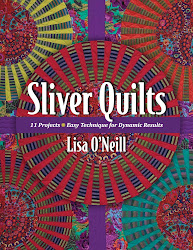I'm revisiting Feeling Blue in this post to show you how I quilted the frame. My inspiration for the frame treatment was tramp art - a form of folk art wood carving created during the depression by hobos using salvaged wood - cigar boxes and fruit crates were popular sources of wood. Frames and boxes are common tramp art applications. Intricate designs were made using simple V shaped notches in the wood, layering notched segments to create intriguing geometric designs as seen below.
So, how did I take this folk art form and interpret it in fabric as a frame for Feeling Blue?
My focus was to create the repetitive imagery of the V notch in every manipulation of the fabric I used in the frame. No other stitch suggests a V as a zig zag stitch. My first step was to quilt the framing background fabric (Moda from the Basic Grey line, and backed with batting) using a zig zag stitch and a red contrasting thread. I quilted the fabric as a whole cloth, and once quilted cut the fabric into strips wider than required to create the tubes which I would construct later to cover the slats of stretcher frame. Layer one of my V notch development.

Moving onto layer two. Layer Two is an open prairie point strip in red. I created the prairie points using the strip cutting and folding method - I did not use the special ruler created for this purpose - you can easily accomplish this without the ruler. Click here to see a great tutorial on this method of creating prairie points. So here are my finished points, a view from the fold side.
 Now I'm ready to anchor the prairie points to the background, right-side up, I simply sewed them into place. I did have a problem with this later - stay tuned.
Now I'm ready to anchor the prairie points to the background, right-side up, I simply sewed them into place. I did have a problem with this later - stay tuned.
Now to create the third layer - it actually consists of 2 steps of V's. Step one involves cutting a strip of wool - I used a beautiful teal gray wool for this portion of the process. I initially tried using a pinking shears to cut the wool but I could not keep to a straight line no matter how hard I tried. I ended up running out to Joann's Fabric with my coupon in hand to purchase the zigzag rotary cutting blade which worked beautifully to cut generous 1/2 inch strips.

Step 2 of Layer three - attaching the wool strip to the background component. I was working with layers of fabric here - batting, background, the multiple folds of the prairie points, and the wool. I used my walking foot to help to move the pinned layers smoothly. Maintaining a straight line was so important to pull off this technique successfully. I used the triple zigzag stitch to anchor the wool strip with a beautiful red variegated thread from the YLI Colours line - I ran out of that beautiful thread after completing three strips of the four strips - PANIC! Emergency call to Ladyfingers Sewing - of course the paper ID from the spool of thread was long lost - I tried to describe the thread to Denise at the shop and she thought she had it in stock. Jump in the car - speed to the shop - eureka! - they had one spool in stock!

Here's my finished strip with three layers of V application.

Now I had to get this fabric into tubes to slide over the stretcher frames. I wanted a tight fit and adjusted my measurements accordingly. I did a number of samples until I was happy with the fit, you should do the same. Sewing the tubes was a piece of cake - turning them was not fun - but, you can do it, be patient, take your time!
Remember I said there was a "complication" with the prairie points - here it comes - duck! When I stitched the prairie points to the background fabric I used a wide zigzag, not for appearance sake - but to try to "grab" the folds and anchor them securely. Unfortunately some of my points began to unfold after the tube turning - no problem a few little hand stitches behind the scenes (and a smitch of glue) can't handle.
The next step in the framing process involved mitering and math - admittedly not my forte, but I got this far and I wasn't giving up. You need to cut your tubes to fit your frame, including cutting the correct angle - it was easier than I thought. Boys need miter boxes - quilters can manage this with a good ruler. Once I cut the tubes to the correct length and angle, it was time to slide them onto the stretcher frames and hand sew the mitered angles together. Stretcher frames are wobbley - but using this treatment really added stability to the wooden frame.

A fourth element of the tramp art application involves hiding the joinery of the hand-stitched corners. I made simple rosettes out of a pinked strip of wool by gathering one edge of the strip and pulling. A handsome silver button helps to anchor the rosette to the corners.

The fifth and final layer of the quilted tramp art process was applied to the quilt, not the frame component. After completing the frame I was very happy with it's overall appearance, but I did not like the overall scale of the frame in relation to the size of the quilt. To enlarge the appearance of the frame I decided to add prairie points to the finished quilt component to peek out from behind the frame perimeter, creating the illusion of a larger frame.

The actual Feeling Blue quilt is attached to the back of the frame using tacks to secure it.
 Tomorrow I'll show you framing method number 2 - it's a lot easier!
Tomorrow I'll show you framing method number 2 - it's a lot easier!












3 comments:
marvelous tut - thank you so much for taking the time to post it - I appreciate it. I quilt outside the lines, much to the chagrin of my very conservative group.
Just came across your blog yesterday with the grilled pizza - dinner tonight.
Your profile photo is THE BEST ! made my day ...
I love this! Great photos of the process too! Thanks!
What a great project! I'm inspired.
Post a Comment